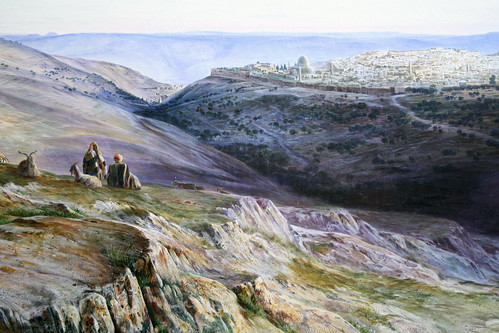Jerusalem (a work in progress not a finished poem-picture)
Comments appreciated.
We look over his shoulder
At Shepherds standing by,
Unmindful of the city.
The open sky is heaven enough for them.
But shining on the other hill
The artist shows so clear
The place they call Jerusalem
So far and yet so near.
A valley lies below us, bare and dark
To me this has to be the shadow of death
A place of desperation, not a country park
Where all too many soldiers took their final breath
The armies of the past, and of the future too
We do not see them now upon the ground
And yet I think I hear their dreadful sound
Out of nowhere, a God without a face
Compels the souls of men to make for this.
It whispers to the world, “This is the place
Which, more than any other, is the source of bliss,
More powerful and wonderful than any lover’s kiss.
For, if there is redemption, it is here.
Come all ye, and enter without fear”.
Over his shoulder we see some goats or sheep
In pastures almost green
A peaceful, restful, pastoral scene
Even the rocks are bright and clean
He might have drawn on William Blake
These could be Northern English hills
An English man’s Jerusalem
to make
Not covered in Satanic Mills
Our fathers went on pilgrimage to reach this holy City
A pure white shining citadel beyond decay
In hope to reach eternity, they made their way,
With prayers in many tongues, and oaths to say.
Some came in peace, some came in holy war
They shared a sacred dream,
Something, for them, worth fighting for.
Thousands fought and thousands died
And thousands more will fight and die
To hold this land. Many
have tried
To find a way of peace, but many lie
And will lie again. I ask you why?
When you believe that God is on your side
You do not count the dead, or lose your pride
We look over his shoulder
For a dream that we hope to come real
A place of beauty love and peaceful games
A place with magnetism, a serene appeal
Where conflicts end in happy resolution
But all these hopes are turned to desolation
The darkness spreading higher on the hill
As war threatens death to every Nation
The beaten child that Lear had left behind
Escaping into nonsense or fine birds
And pastoral landscapes of this remarkable kind
Where sheep and goats go grazing without turds
And men sit silently, no words
Upon their lips. Perhaps his promises had all been kept
Or maybe he stood here, painting while he wept.
There is one more stanza to come
















































